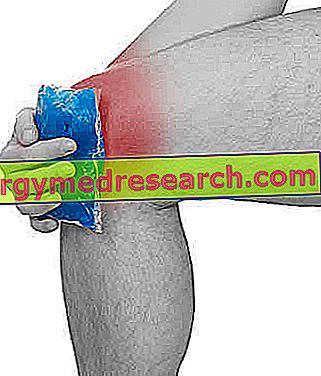Generality
An articular effusion is an abnormal accumulation of fluid, within a synovial joint of the human body.

A joint effusion can be the result of a trauma, a contusion, a haematological disease, a particular form of arthritis, an infection or a local condition.
The symptoms and signs that usually accompany a joint effusion are: pain, swelling, joint stiffness and limited joint mobility.
The treatment depends on the triggering causes and on the intensity of the symptoms.
Short anatomical reference on the joints
The joints are anatomical structures, sometimes complex, which put two or more bones in mutual contact. In the human body, there are about 360 of them and their task is to keep the various bone segments together, so that the skeleton can fulfill its function of support, mobility and protection.
The anatomists divide the joints into three main categories:
- Fibrous joints (or synarthrosis ), lacking in mobility and whose bones are joined by fibrous tissue. Typical examples of synarthrosis are the bones of the skull.
- Cartilaginous joints (or amphiarthrosis ), with poor mobility and whose bones are linked by cartilage. Classic examples of amphiartrosis are vertebral vertebrae.
- The synovial joints (or diarthrosis ), provided with great mobility and made up of various elements, including: the so-called articular surfaces, the joint capsule, the layers of cartilage that cover the articular surfaces, the synovial membrane, the synovial bags and a series of ligaments and tendons.
Typical examples of diarthrosis are the joints of the shoulder, knee, hip, ankle, etc.
What is a joint effusion?
An articular effusion is an unusual accumulation of fluid within a synovial joint of the human body.
In normal conditions, in the synovial joints there is a certain amount of liquid, which has the task of reducing the friction between the various structural components of the joint.
In the presence of joint effusion, however, there is an excess of fluid in the synovial joint involved.
IDRARTO AND EMARTRO
The fluid that characterizes a joint effusion can be serous or contain traces of blood. If it is only serous, it takes the specific name of hydrart ; if instead it contains traces of blood, it is more specifically called emartro .
MOST COMMON LOCATIONS
The most common synovial joints subject to joint effusion are: knees, elbows, ankles and hips.
Causes
The causes of joint effusion are numerous.
The most common triggers include: traumas, bruises, various forms of arthritis, some hematological diseases, some infectious systemic diseases and, finally, specific local conditions.
TRAUMAS AND CONTUSIONS
Traumas and bruises are the cause of joint effusion when they damage some of the structures forming the affected joint, in this case: ligaments, tendons, joint bones and / or cartilaginous surfaces.
ARTHRITIS
In medicine, the term arthritis refers to any inflammatory condition that involves one or more joints.
Different forms of arthritis can cause joint effusion.
The most common types of arthritis that cause joint effusion include:
- Osteoarthritis (or arthrosis ). The inflammation derives from a progressive deterioration of the cartilage layer that covers the articular surfaces.
- Rheumatoid arthritis . The inflammation has an autoimmune origin, that is it arises due to a malfunction of the immune system. The precise site of inflammation is the synovial membrane.
- Septic arthritis . Inflammation of the joint or joints is due to a bacterial infection.
- Gout . It is a metabolic disease which, among the various possible consequences, also determines the deposition of urates in the articular cartilages; these urates are responsible for an inflammatory state in the joints involved.
HEMATOLOGICAL CONDITIONS
Among the hematological conditions that may be the cause of joint effusion (in this case hemarthros), haemophilia deserves special mention.
Hemophilia is an inherited genetic disorder that affects the blood and affects the normal blood clotting process. In those affected, haemophilia is responsible for prolonged bleeding, even after trivial trauma or minor skin cuts.
The cause of hemophilia is a genetic mutation affecting the sex chromosome X, a mutation that determines the deficiency of one of the coagulation factors.
SYSTEMIC INFECTIOUS CONDITIONS
The most known systemic infectious conditions, which can cause a joint effusion, are tuberculosis and syphilis .
Note: in medicine, the systemic term, combined with a pathology, means that the latter affects various organs and tissues of the body.
LOCAL CONDITIONS
The most common local conditions, which can cause joint effusion, are bursitis . Bursitis is the inflammation of one or more synovial bags that surround a joint.
Less common local conditions, which can cause joint effusion, are cysts and tumors.
For further information: the following are articles, which deal with local conditions responsible for joint effusion in the main synovial joints of the human body:
- Knee bursitis
- Elbow bursitis
- Baker cysts
Symptoms
As a rule, the symptoms and signs that characterize a joint effusion are: pain, joint stiffness, swelling, limited mobility, redness and noise during the movement of the affected joint.
Diagnosis
For a correct diagnosis of joint effusion, the physical examination and the medical history are sufficient in almost all cases.
If more information is needed, especially to fully understand the precise causes, doctors can use diagnostic imaging tests (X-rays, MRIs, etc.), laboratory analyzes of excess fluid, contained in the painful joint, and - in really extreme cases - a diagnostic arthroscopy.
Treatment
The treatment of a joint effusion depends on two factors:
- First, from the triggering causes . To remedy or, at least, try to contain the factor that causes joint effusion is essential to eliminate the latter or at least avoid its deterioration;
- Secondly, from the intensity of the symptomatology . Generally, in the presence of a mild symptomatology, a conservative treatment may suffice; on the contrary, in the presence of a particularly serious symptomatology, the use of surgery is almost always indispensable.
EXAMPLES OF CONSERVATIVE TREATMENTS
Some examples of conservative treatments for joint effusion are:
- Rest of the painful joint. As a rule, rest is the starting point of any recovery path;
- The application of ice on the painful joint at least 4-5 times a day:
- The suspension of all those activities that tend to worsen the joint pain ;
- The administration of anti-inflammatory drugs (paracetamol, NSAIDs and / or corticosteroids), to reduce inflammation and the consequent pain;
- The administration of immunosuppressive drugs, if the joint effusion is due to an autoimmune disease;
- Administration of antibiotics, if the joint effusion is subsequent to a bacterial infection;
- Physiotherapy ;
- The aspiration, through a needle, of the excess liquid, contained in the affected joint.
SURGERY
Arthroscopy operations are the most commonly used surgical procedures in case of joint effusion.



